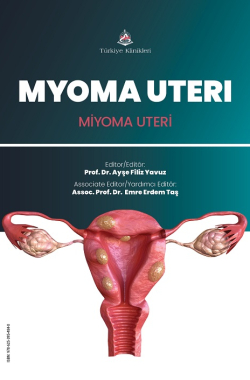Pathological Classification of Leiomyoma and Types of Degeneration
Kübra Katipoğlu1
Fazlı Erdoğan2
1Ankara Bilkent City Hospital, Department of Pathology, Ankara, Türkiye
2Ankara Bilkent City Hospital, Department of Pathology, Ankara, Türkiye
Katipoğlu K, Erdoğan F. Pathological Classification of Leiomyoma and Types of Degeneration. Yavuz AF, ed. Myoma Uteri. 1st ed. Ankara: Türkiye Klinikleri; 2025. p.27-32.
ABSTRACT
Leiomyomas are common, benign tumors originating from the smooth muscle of the uterus. They can vary in size and are often multicentric. Macroscopically, they have a characteristic firm, whorled appearance and are white when freshly cut. In cellular leiomyomas and lipoleiomyomas, the color may change to yellow. Red degeneration is seen in cases of oral contraceptive use or pregnancy and has a beefy red appearance, while myxoid degeneration results in a gelatinous and sticky surface. Leiomyomas lack a capsule but are well circumscribed and can be easily enucleated. In some cas- es, calcification and necrosis can be observed, and large leiomyomas may show cystic degeneration. The symptoms of leiomyomas vary depending on their size and location (submucosal, intramural, or subserosal). Although rare, they can be found outside the uterus in areas like the vulva, cervix, broad ligament, and ovary. Hereditary syndromes associated with leiomyomas include hereditary leio- myomatosis and renal cell carcinoma (HLRCC) and Alport syndrome. Microscopically, leiomyomas consist of spindle-shaped cells that form fascicles with elongated, cigar-shaped nuclei. These tumors typically show low mitotic activity and lack significant atypia. Leiomyomas are classified based on mitotic activity, atypia, and tumor necrosis. There are two main types of necrosis seen: infarction-type necrosis (with regular, expansile borders) and coagulative necrosis (with irregular, sharply demarcated borders). Ulceration can occur in submucosal leiomyomas. Leiomyomas form a spectrum, with typical benign forms at one end and leiomyosarcomas at the other. The classification is determined by mitotic activity, necrosis, and atypia, with specific thresholds for mitoses in high-power fields. Leiomyomas have various subtypes, including mitotically active leiomyomas, cellular leiomyomas, hydropic leio- myomas, apoplectic leiomyomas, fumarate hydratase-deficient leiomyomas, leiomyomas with bizarre nuclei, and leiomyomas containing other cellular elements such as adipocytes. There are also epithe- lioid leiomyomas, myxoid leiomyomas, dissecting leiomyomas, and diffuse leiomyomatosis. These subtypes, each with distinctive pathological features, help in the accurate diagnosis and treatment of leiomyomas.
Keywords: Uterus; Leimyoma; Smooth muscle tumor
Kaynak Göster
Referanslar
- Cramer, S.F. and A. Patel, The frequency of uterine leiomyomas. Am J Clin Pathol, 1990. 94(4): p. 435-8. [Crossref] [PubMed]
- Ordulu, Z., Fibroids: Genotype and Phenotype. Clin Obstet Gynecol, 2016. 59(1): p. 25-9. [Crossref] [PubMed] [PMC]
- Liu, I.F., et al., Mitotically active leiomyoma of the uterus in a postmenopausal breast cancer patient receiving tamoxifen. Taiwan J Obstet Gynecol, 2006. 45(2): p. 167-9. [Crossref] [PubMed]
- Miettinen, M., et al., Fumarase-deficient Uterine Leiomyomas: An Immunohistochemical, Molecular Genetic, and Clinicopathologic Study of 86 Cases. Am J Surg Pathol, 2016. 40(12): p. 1661-1669. [Crossref] [PubMed] [PMC]
- Oliva E, Cheung A, Lax S. WHO Classification of Tumours of the Female Genital Tract. World Health Organization; 2020.

